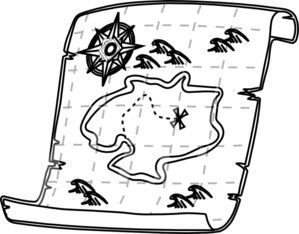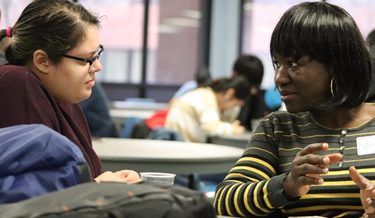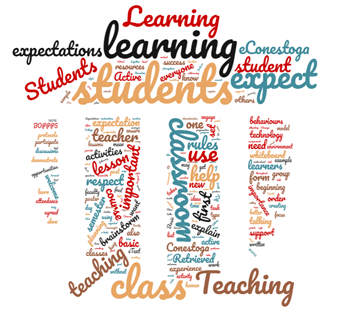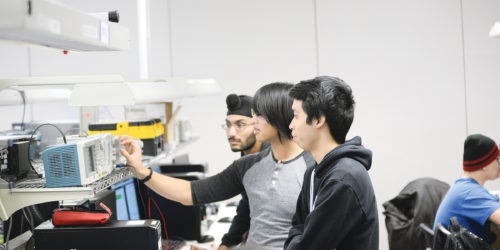
The First Two Weeks: Basic Classroom Expectations

At its best a classroom is a dynamic setting where teacher and learners support each other on the journey toward a common learning goal in keeping with the course learning outcomes. As you set the tone for your class this semester it is important to reflect on appropriate classroom expectations for facilitating learning. This teaching tip suggests basic expectations for faculty and students to create an atmosphere that supports learning for everyone in the class.
What can students expect from you?
As the classroom instructor what can students expect from you as you foster a setting conducive to their learning?
A warm welcome

The academic success of a diverse student body begins with a sense of inclusion and security. Students who feel welcome and safe in their classes will be one crucial step closer to the kind of engagement needed for successful learning (Cox and Strange, 2016, p. 216). A warm welcome takes the form of ice breaking activities, but welcome is also reflected in positive language and in attention paid to making sure expectations are clear and supports are in place for all learners.
Clear expectations
Conestoga’s student body is diverse, and classroom expectations must be clarified to ensure that everyone understands them, regardless of their previous experience. Clarification often takes the form of learning activities. For example:
- If regular use of eConestoga is an expectation, why not encourage everyone to log in on the first day and help trouble-shoot for anyone who is having difficulty?
- If using e-texts is crucial to student success, create a step-by-step discovery activity for students to try using their e-texts in their first or second class. This demonstrates how to use an e-text AND provides evidence that you value the course text.
Mutual respect
Respect is the most basic ingredient to make the effective interaction between teacher and learners possible. The duty to ensure mutual respect falls to you as the teacher. 15 to 20 minutes spent in the first week creating a set of mutually agreed upon class protocols can help set a tone of mutual respect which you can return to in later classes if behavioural issues arise (Jackson, 2019, P. 38). Here are some sample ways to generate a list of protocols together with your students.
Create a Poster

On chart paper or on the whiteboard, draw an outline of a human form. Have students brainstorm classroom behaviours and characteristics that will enhance their own learning. These are written on the inside of the human form. Have students also brainstorm behaviours and attitudes which would hinder their learning and which they agree not to engage in. These items should be written outside the human form. You could give two examples first, such as “showing everyone respect” on the inside and “laughing at others’ mistakes” on the not-to-be done outside. Another good practice is to have students sign the poster to indicate that they agree to the list. You can take a picture of the poster and post it on eConestoga.
What do you need?
Another brainstorm activity consists of creating three headings with questions for groups of students to consider. On the whiteboard or on posters on walls around the room, the activity set-up would look like this:
For your success in this class:
| What do you need from yourself? | What do you need from each other? | What do you need from the teacher? |
Discuss the collective results (written on the whiteboard or on post-its under the posters on the walls) to ensure that everyone agrees. You can then type up the resulting lists and post them on eConestoga as the classroom protocol for the semester.
ROPES
If you want to begin with a ready-made set of protocols, you can post them on the board, explain them, and have students discuss what each item means to them. An acronym I have used in the past is ROPES.
| Acronym | Possible comments for each |
| Respect | (For each other – this includes respect for diversity. What does that mean to you?) |
| Openness | (To new ideas and ways of learning – how can we be open to new things?) |
| Participation | (Participate in learning activities – with the option of a pass, no questions asked.) |
| Equity | (Fair does not always mean exactly the same. The goal is everyone’s success. What does equity mean to you?) |
| Support | (Groups which cooperate outperform groups which do not. We will all do better if we support each other in learning. What are reasonable expectations of support?) |
The advantage of an acronym is that if counter-productive behaviours arise later in the semester, you only have to say “remember the ropes” without singling students out, and if you are consistent, it can be a simple tool to help keep learning on track.
What can you expect from students?
What basic behaviours you can expect from students in the classroom? The fewer “rules” the better, but the following four rules can help you set the tone for a classroom atmosphere conducive to learning:
- No one talks while the teacher is addressing the class.
- No one talks while another student is addressing the teacher.
- When students are working on a task, their conversation should relate to the deliverable task.
- If a student enters the classroom while the lesson is in progress, no talking should occur.
[Teaching and Learning Conestoga]. (2019, August 15). Students Talking in Class [Video File]
Even after you have stated these rules, some students, while feeling a great deal of cultural respect for the teacher, will also expect the teacher to show authority in enforcing expected classroom rules of comportment. If some students are talking and other students can’t hear your teaching, be ready to bring students back to the rules as many times as it takes for the group to settle into a quiet, attentive mindset. This can be done firmly without anger or attitude. Ask, “What is the first rule?” Then don’t start teaching again until the class is quiet.
If reinforcing classroom etiquette feels uncomfortable for you in the beginning, you can remind yourself that an authoritative teaching style (what some international students expect) is not the same as an authoritarian teaching style (not desired by anyone). Basic classroom rules can be reinforced without anger or emotion on your point once all the students have agreed from the beginning of the term that the rules are fair and reasonable.
NOTE: If students are talking to each other to help each other understand your teaching points, it is important to provide them with regular opportunities to exchange information and explanations so that they won’t feel the need to talk while you are talking.
What can you and your students expect from the learning environment?
Everyone should be able to expect to focus on learning in class. However, when it comes to how that focus should occur, you can’t expect students to read your mind.
Students new to a North American learning environment, older students who have not been in class for several years, and students who are the first in their families to go to College will not necessarily know what they can expect from you and what you expect from them. Here are some suggestions for creating an inclusive and safe yet stimulating environment for learning.

An agenda
Create an agenda for each class and write it on the whiteboard so that you can explain it at the beginning of class and students can refer to it throughout the rest of lesson. Point out the importance of each item to the learning of the day.
The importance of attendance
There may be some students in your class whose experience with high school was that class attendance was optional and that extra-curricular “coaching classes” were where most of the learning took place. For these and other students, it is important to both explain and demonstrate the importance of attending class. You can explain that the class IS the coaching class where students can expect to learn, practice, and prepare for assessments. Equally important, you can plan from day one to engage learners in meaningful learning activities, pointing out how the learning will help them pass the course. In the end, of course, it is each student’s decision to attend class or to take the consequences if not attending class leads to poor learning outcomes.
NOTE: It is an expectation that you maintain a record of attendance for all your classes.
Active learning opportunities

Research has shown that active learning in class improves student learning and retention (Bernstein, 2018); this is why it is an expectation at Conestoga that lessons will be planned with active learning in mind. “Active learning is an approach to instruction that involves actively engaging students with the course material through discussions, problem solving, case studies, role plays and other methods (Active Learning, n.d.).” Active learning engages higher order thinking skills; students are guided in working with information in order to better understand and apply it.
Effective Lesson Planning
On the one hand, students at Conestoga can expect lessons which provide active, meaningful learning opportunities. On the other hand, Conestoga faculty can expect guidance in how to make this happen. We recommend the BOPPPS model of lesson planning to help you engage learners throughout the lesson. Please refer to the attached BOPPPS lesson planning infographic and the Faculty Orientation Handbook for guidance in planning a BOPPPS lesson.
Modelling
As you plan your lessons, prepare to model every behaviour you wish to see. For example:
- If you want students to brainstorm ideas, start the brainstorm with sample ideas.
- If you want students to participate in small group discussions, give them explicit instructions so that they will know what to do. For example, rather than asking students to discuss the importance of a topic, ask each group to list the top 3 reasons why the topic is important. Students new to in-class discussions now have a concrete task to work toward.
Once students become comfortable with classroom learning processes, you can become less detailed with instructions, but it is safer not to assume that students will know what is expected.
Positive Reinforcement
If you want students to keep coming to class and to participate in class, keep your messaging positive. If a student contributes to the class, even if you had to recast it a bit, thank them genuinely for contributing. Even when participation is an expectation of the class, the act of speaking up involves risk. Rewarding the risk will encourage a student to participate again.
Basic Expectations and Technology
While Millennial and Generation Z students bring particular characteristics to their learning, including high comfort with the use of technology, G. J. Dungy points out that cohorts are not monolithic, and that it is still important to get to know our students for who they are beyond the label they are assigned by demographic studies (2011, p. 5). This is true of Conestoga students. Many of our students are technologically sophisticated, while others will have made very little use of technology as part of their prior education. We can expect students to use technology; we can also expect to demonstrate how to use technology and to show patience with students as they learn.
eConestoga
There will be a range in students’ experience of the use of learning management systems. Some will find learning eConestoga easy, while others will be challenged. You can expect students to use eConestoga, but it will be important to demonstrate how to access the Instructional Plan, the assessments, and the learning materials.
Word documents
It is a basic expectation that students type up their assignments using Word unless otherwise instructed. Some of your students will feel at home with word processing; others may never have used a word processor before and may spend much more time than other students on their assignments for this reason. It will be helpful to these students if you explain your minimum expectations and show them where they can find a sample of the assignment type to use as a model. This is especially true in the first semester of your students’ programs.
E-texts
For those of you who work with an e-text, you have access to e-text resources under the faculty support tab in eConestoga or directly from the publisher. The same resources are available to your students as part of the description of the e-text link in your course. Students who are not comfortable with online resources will benefit from e-text-related in-class activities to help them learn how to use the text.
Online resources
Students who are not comfortable with online resources will benefit from e-text-related in-class activities to help them learn how to use the text.
The Learning Journey

You and your students are on an exciting, often challenging journey of learning together, and every group of students brings new surprises, delights, and challenges. The basic expectations described in this teaching tip represent a framework of preparation for the classroom experience. The preparation involved should free you up once you get to class so that you can focus on the students and their learning. If you would like to talk further about teaching and learning at the beginning of a semester, don’t hesitate to get in touch with any of the Teaching and Learning team at teachingandlearning@conestogac.on.ca.
References
Active Learning. (n.d.). Retrieved December 1, 2019, from http://www.queensu.ca/teachingandlearning/modules/active/04_what_is_active_learning.html
Bernstein, D. A. (2018). Does active learning work? A good question, but not the right one. Scholarship of Teaching and Learning in Psychology, 4(4), 290–307. https://doi.org/10.1037/stl0000124
Cox, D. G. H., & Strange, C. C. (2016). Serving Diverse Students in Canadian Higher Education. Montreal: MQUP. Retrieved from https://search.ebscohost.com/login.aspx?direct=true&db=nlebk&AN=1290381&site=eds-live&scope=site
Dungy, G. (2011). A National Perspective: Testing our Assumptions about Generational Cohorts. In Howard-Hamilton, M. F., Marbley, A. F., & Bonner, F. A. (Eds.). Diverse Millennial Students in College: Implications for Faculty and Student Affairs (5-21). Sterling, VA: Stylus Publishing. Retrieved from https://search.ebscohost.com/login.aspx?direct=true&db=nlebk&AN=440867&site=ehost-live&scope=site
Jackson, R. (2019). RESPECT from Day One. Educational Leadership, 77(1), 36–41. Retrieved from https://search.ebscohost.com/login.aspx?direct=true&db=tfh&AN=139511642&site=eds-live&scope=site
[Teaching and Learning Conestoga]. (2019, August 15). Students Talking in Class [Video File]. Retrieved from https://www.youtube.com/watch?v=7s96OD4u9AQ






